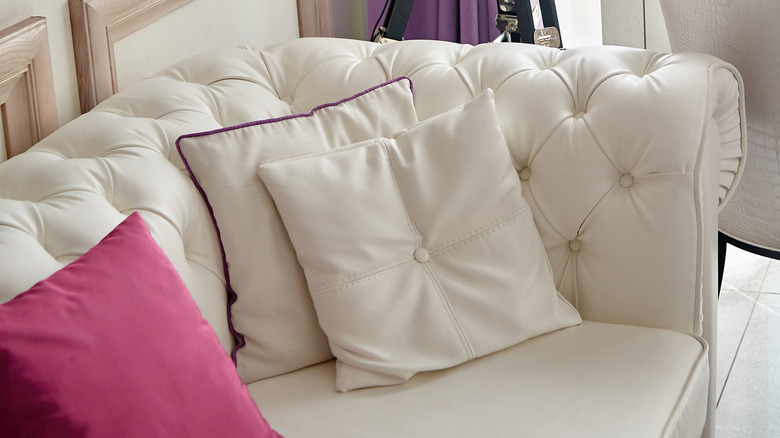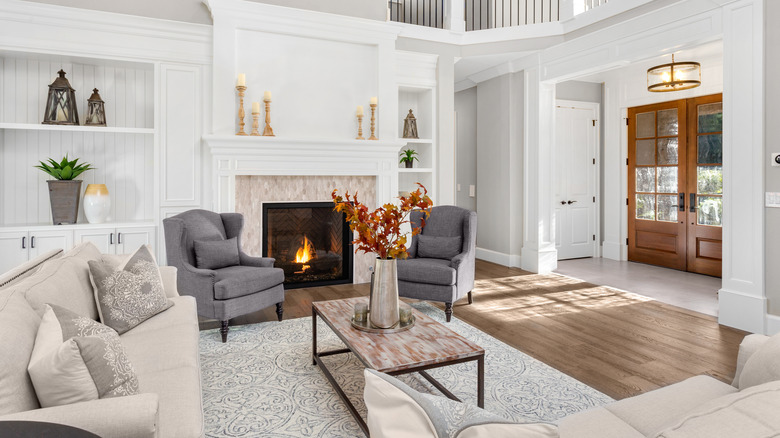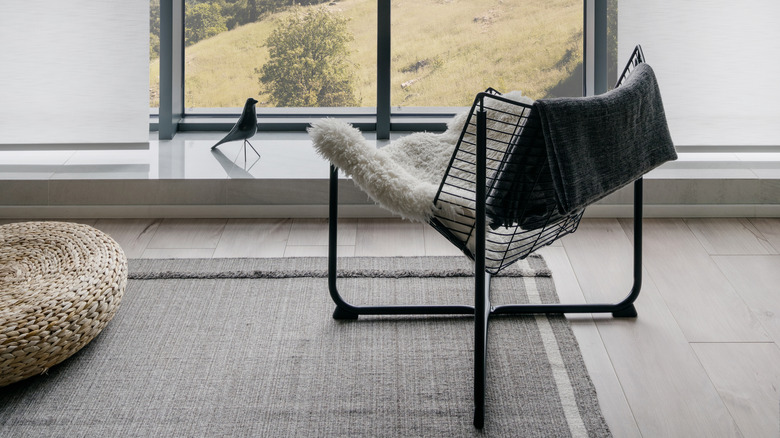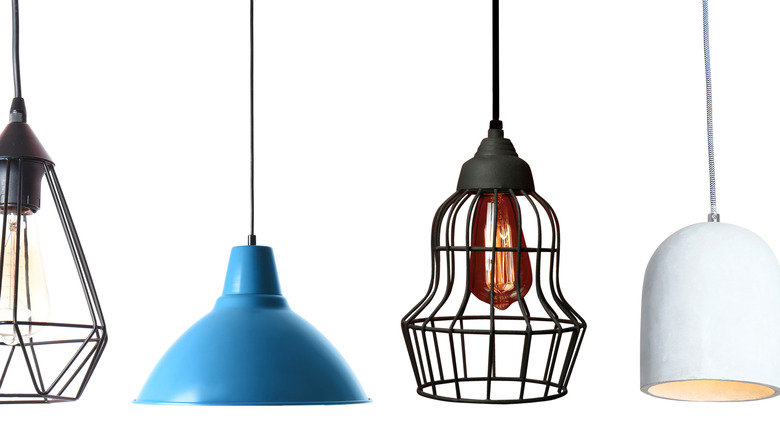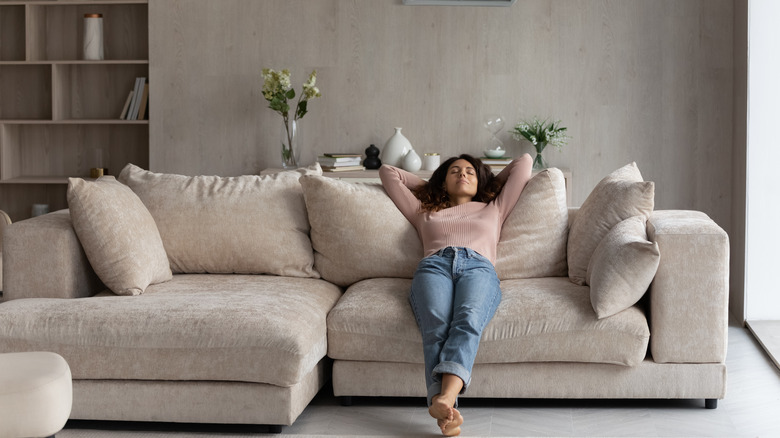Shea McGee's 5 Tips For Creating A Timeless Traditional Living Room
When it comes to home interiors, everyone has their own preferred styles. Some love to be surrounded by stark, clean lines in a modern space. Others favor a farmhouse approach with plenty of natural textures and cozy touches. For many, though, a traditional design style is the key to creating a stunning space that they'll love for years to come.
As Decoraid explains, a traditional interior is one of the more popular design styles because it's timeless. It allows you to incorporate pieces from different eras that strike your fancy while still keeping a relatively cohesive, elegant look. Interiors by Steven G names some of the characteristics of traditional design, such as a European influence, a rich, dark color palette, eye-catching architectural elements, and elegant accessories.
And unlike trendier styles that can appear dated quite quickly, as new interior trends emerge, you'll never really have to fully overhaul a space done in a traditional style (unless you drastically change your preferences). Instead, you can continue adding or making small adjustments to cultivate a warm space that truly reflects your personality and acts as a haven for you after a long day.
Interior designer Shea McGee from Studio McGee transforms space in her traditional with a twist aesthetic, and as Hunker reports, she has a few tips for creating a timeless, traditional vibe in one of the key spaces in your home where you likely spend much of your time — the living room.
1. Go classic with your key pieces
With traditional design, while you can definitely mix things up with accents and decorative pieces from different eras, you do want to keep the key pieces relatively classic. In your living room, this means staple furniture items like your couch, as McGee outlines for Hunker.
When selecting a couch for your living room, you want a neutral color — this could either be something on the lighter end of the spectrum, like cream and beige or something a bit more dark and rich, like a deep navy blue. You'll also want to select a classic shape, although there's plenty of variety within that category, so you can find something you absolutely love. Curated Interior suggests going for a wide-set sofa and looking for designs that take inspiration from earlier time periods, such as a classic tufted Chesterfield or a sofa with Victorian or European influences.
Another integral piece for most living rooms is the coffee table. As McGee suggests, you'll want something that's a timeless style that will work design-wise with your couch. And as for an area rug that takes up a large portion of the floor space in your living room, you want something that adds a bit of design without making a massive style statement.
Going in a classic direction for these key pieces in your living room will give you a great foundation to build on.
2. Contrast is always chic
Traditional style is all about mixing pieces from different eras, and while you do want to be a bit mindful of how everything will work together, you absolutely don't need to be cohesive in the sense of sticking to one color palette or minimizing patterns. As McGee explains to Hunker, contrast is actually really important in a traditional style space, and you shouldn't shy away from it.
This could be incorporated with the colors you are using, such as pairing your beige sofa and cream armchairs with pillows in rich, saturated hues like sapphire green and garnet. However, it could also mean contrast in silhouettes. McGee recommends pairing pieces that have a streamlined silhouette with pieces that have a more sculptural shape, for example. It could even mean mixing different textures or finishes, such as pairing matte accessories with glossy accessories in your bookshelf vignettes or adding linen pillows to your velvet sofa.
As Hudson and Crane explains, too much cohesion within a space will make it feel monotonous. Contrast helps bring a room to life and make it feel interesting and dynamic rather than boring and dull. Though it may seem like it makes sense to stick with a certain color palette, finish, or shape, incorporating variety will yield a much more vibrant space — it won't feel like a chaotic mess when done correctly.
3. Don't be afraid to use modern pieces
For many individuals, an entirely modern style can feel a bit too stark and cold for their home, especially for a space like your living room. The living room is where you spend a ton of your time, lounging and relaxing and doing the things you love, and you want the space to support those needs. Functionality is key in any room of your home, as MyMove reports.
However, that doesn't mean you can never incorporate modern pieces — in fact, McGee encourages individuals to add in a few modern pieces when possible, as Hunker reports. And, you don't have to stick with just the smallest possible items like accessories. While you want to go in a classic direction for large elements like your sofa or coffee table, don't be afraid to add a modern end table or armchair, for example.
Deutsch Furniture Haus recommends using an 80/20 ratio rule when mixing modern and traditional. So, 80% of your furnishings and the elements in your space should be classic, while 20% can go in a more modern direction.
As McGee explains to Hunker, mixing these modern pieces with the more traditional spaces that serve as the foundation for your living room will help you create a space that feels a lot more layered.
4. Incorporate trends as accessories
Accessories are one of the best ways to play around with trends while still making sure your space feels timeless. Just think about what makes an impact when you walk into a room — you may be taken aback by a super trendy sofa that dominates the space and just doesn't mesh with everything else in the room, whereas a bold art piece might catch your eye for a much more positive reason.
So, don't be afraid to think outside the traditional box when it comes to the accessories in your living room, and don't think you have to embrace the same style, even within the same category. For example, McGee shared an image with Hunker of a living room that Studio McGee transformed. In the image, they have a couch flanked by one traditional table lamp and one more modern, sculptural floor lamp, and it works perfectly. Similarly, Style by Emily Henderson flags oil portraits and still life paintings as a key modern traditional accessory. Why not mix a piece like that with a pop art piece in a similar color palette to create a unique look?
While there are certainly best practices in interior design and rules that can help your space look its best, such as following certain proportions for hanging art or how to position your furniture, ultimately, it's a matter of finding pieces you love — which leads us to our next point.
5. Follow your heart
With any design style, you should embrace the pieces or elements that you truly love, and feel free to skip the ones that don't quite mesh with your desired aesthetic. That's especially the case with a traditional style — since it's so layered and multi-faceted, you can truly bring in whatever speaks to you and whatever you truly love, as McGee tells Hunker.
So, resist the urge to create a formula for the perfect, seemingly spontaneous traditional interior, such as the need to have two modern pieces, one vintage piece, and five classic pieces. While some rules of thumb can guide you, ultimately, just follow your heart. If you find a piece that you absolutely love, find a space for it in your living room. This could be a pillow with a print that brings you joy, an interesting lamp with a zany shape, or a piece of art you can't live without. As Simply Home Decorating explains, your home should show off your personality. While many are inclined to put more personal pieces in their bedrooms or offices, spaces visitors don't see quite often, why not include items in your living room that will spark conversations?

